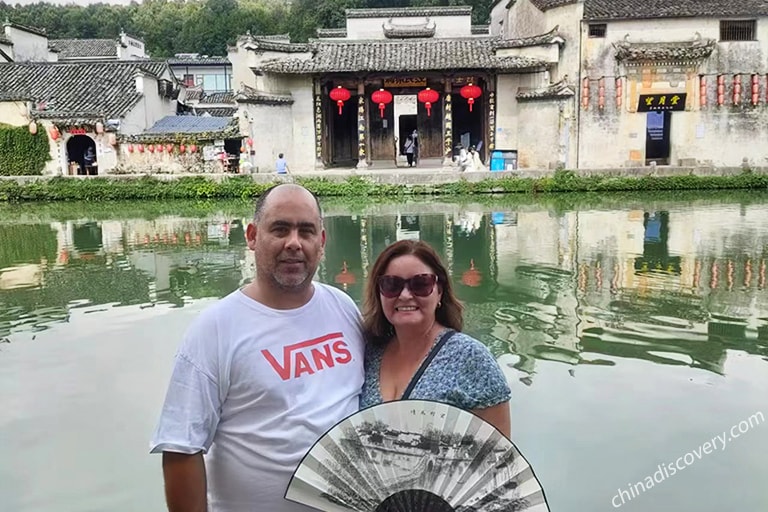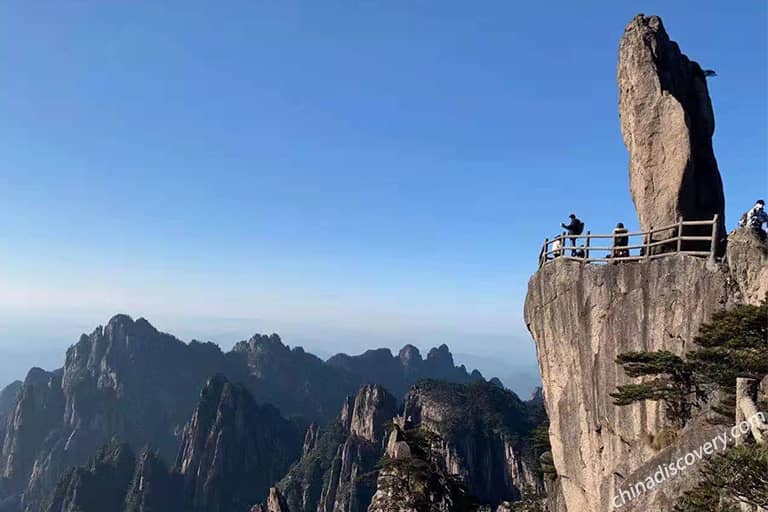Huizhou Architecture – Important Branch of Traditional Chinese Architecture
Huizhou architecture, the treasure of traditional Chinese architecture, is a combination of simplicity and complexity. The exterior looks quite simple from the distance, such as the huge white walls, small black tiles, and grand archways. But looked closer, it is a very different world. You will be amazed at the fine craftsmanship of the lively carvings on those architecture and the rich Huizhou culture indicated through its layout. This article will provide you with the essential information about Huizhou architecture, including its history, main features, structure, and recommended visiting places.
What is Huizhou Architecture
Huizhou architecture is one of the most important schools of traditional Chinese architecture. It is typical in six counties of historical Huizhou Prefecture in Anhui Province and surrounding Hui language speaking areas such as Shitai, Fuliang, Dexing.
Huizhou architecture mainly takes a wooden structure and adopts bricks, wood and stones as raw materials. Its basic colors are white, black, and gray. The broad application of brick carving, wood carving and stone carving has showed its high-level decorative art. Residential houses, ancestral halls and archways, known as the three outstanding representatives of ancient Huizhou architecture, are highly valued and admired by both Chinese and foreign architects. Among the three, residential house is the essence part, so it will be given more emphasis in this article.
History of Huizhou Architecture
Huizhou architecture was deeply influenced by the unique historical and geographical environment of Huizhou and humanistic values of Huizhou people. Huizhou is a mountainous area and originally a settlement of the ancient Yue people (a large group of people living in the south of Yangtse River about 2500 years ago). To adapt to the humid mountain climate, they have designed the stilt-style house, which is built a little higher than the ground and supported by a couple of wooden columns. People usually live in the second floor and keep livestock in the first floor. This kind of setup remains in the early Huizhou houses in the form of “lobby upstairs”. When a large number of people from Central Plains (comprising the middle and lower reaches of the Huanghe River) moved into Huizhou, people needed to rethink the housing problems on this small land. So they transformed the quadrangle courtyard brought by Central Plain people into Hui-style patio. Considering the wooden structure is vulnerable to fire, they created the unique horse-head walls. So to speak, Huizhou residential house is a combination of Yue culture and Central Plains culture.
After the mid-Ming Dynasty (A.D. 1368-1644), Huizhou merchants dominated Chinese business field and many of them made a great fortune. They began spending a large amount of money in building ancestral temples, houses, gardens, archways, bridges and pavilions, which brought great changes to the rural landscapes of Huizhou. Huizhou people had the tradition of valuing education, so most Huizhou merchants were well-educated. They had their own artistic taste. So they attached much importance to the layout, structure, and decoration of the architecture, which promoted Huizhou architecture to gradually form a unique architectural system, making Huizhou architecture not only practical, but also rich in cultural contents.
 Huizhou Architecture
Huizhou Architecture
 Our Guests Visited Xidi Hu Wenguang Archway
Our Guests Visited Xidi Hu Wenguang Archway
Features of Huizhou Residential House
Residential house is the most representative of Huizhou architecture. Over hundreds of years, it has grown into a cultural icon of Huizhou. The white wall & black tile, dynamic horse-head wall, symbolic patio, fancy arches and carvings all tell the visitors that this is a Huizhou residential house.
White Wall & Black Tile
White wall and black tile is probably the first impression left by a Huizhou residential house. This white & black color combination is not chosen in random. Actually, it is related to the environment, building material, politics and culture in Huizhou.
Huizhou is rich in building materials, including high-quality timber such as pine, fir, cypress, and natural coatings like tung oil and raw lacquer. Therefore, Huizhou people just build their houses with local materials, which are, natural timber, rubble, gray plaster, black brick and tile. In addition, Huizhou is rich in rainfalls, especially from May to July. To prevent the house walls from erosion by wind and rain, the ancient Huizhou people usually painted white lime on the exterior walls.
In feudal China, the use of colors was strictly regulated. For example, yellow was exclusive to royal uses. Using the wrong color may get one into big trouble. Most Huizhou people made a living by doing business, but in the old days, the Chinese society encouraged agriculture rather than trade. So it was safer for Huizhou people to resort simple colors on their houses. What’s more, it was also consistent with their aesthetic values. Huizhou is the hometown of the great scholar Zhu Xi (A.D. 1130 - 1200). He is an influential Neo-Confucianist, philosopher, educator, and poet, who has always advocated the plain and natural aesthetic ideas. Taking it as a leading idea, Huizhou people seldom use showy colors but tend to choose the simple white and black.
 Huizhou Residential House
Huizhou Residential House
 Huizhou with White Wall Black Tile
Huizhou with White Wall Black Tile
Arch over the Gate
The entrance door of a Huizhou house is always equipped with an arch above to prevent rainwater from flowing down the walls to the doors. Generally, the arch over the gate of a ordinary family is relatively simple. It’s on the wall a little higher than the door frame. An small-sized eave sticking outwards is built by terrazzo bricks, covered with tiles, and carved with some simple patterns for decoration. While in a wealthy family, the arch is very fastidious and usually adorned with fine brick carvings or stone carvings.
The arch to the house is like the face to a man. It shows the social status of the owner. There are three kinds of arches. The first one is door-cover type, the simplest and most common one as we discussed above. The second one is archway type. It is like engraving an archway into the wall, much grander and more complex than the previous one. The third one is a variant. The gate retreats inward for some distance and the wall looks like the Chinese character “eight (八)”, indicating its owner is a government official.
Horse-head Wall
Horse-head wall refers to the wall that is higher than the gables. But it is not triangle as we usually see. As the name shows, it resembles the shape of a horse head. Horse-head wall is constructed tier upon tier like stairs and covered with small black tiles. At the outer end of it, i.e. the horse head part, there will be a verge board. In a compact Huizhou village, when a fire occurs, it is easy to spread along the wood-built houses and causes huge losses. Therefore, ancient Huizhou people build horse-head wall to prevent the fire. But over time, it has become a special architectural style in Huizhou area.
The well-arranged, black-and-white horse-head wall brings people the enjoyment of simple but pure and elegant beauty. Huizhou residential houses are mostly tall and enclosed. But the static and rigid walls show a dynamic aesthetics because of the up-and-down horse-head walls. They create a image like "ten thousand horses galloping ahead", which also shows that the villagers wish the vitality and prosperity of the whole village.
 Huizhou Horse-head Wall
Huizhou Horse-head Wall
Patio Inside the House
Patio is an open space circled by rooms or walls in the house. In Huizhou, there are not many windows on the high exterior walls. Because the adult males are out doing business almost all year round, with only the women, children, or the senior at home. This kind of design may help keep the thieves or other bad people out. In this case, a patio is essential to ensure enough lights and ventilation in the house. Apart from that, it is also a place for drainage and rainwater storage when it rains.
But why would they store water? One explanation is that it is for emergency needs in case there is a fire. Another reason, also the more important one, is related to Fengshui (Chinese geomancy), which believes that water is the source of money. As mentioned before, Huizhou is a place where many successful merchants are cultivated. It is the merchants’ taboo to let the source of money flow to the outside. With patios built, the rainwater will flow along the eaves into the house when it rains, which means they are able to keep the money inside.
 Huizhou Patio
Huizhou Patio
Carvings on Huizhou Architecture
Brick carving, stone carving, and wood carving are called the three carvings on Huizhou architecture for artistic decoration. They originated in the Song Dynasty and thrived in the Ming and Qing Dynasty.
Brick carving is a kind of architectural decoration exquisitely carved on the solid bricks specially produced in Huizhou. It is widely used in the arches, doorsteps, lintels, eaves, roofs, roofs and other places, endowing the buildings with a sense of elegance and solemnness. It is an important part of the Hui-style architectural art that has risen since the Ming and Qing Dynasty. Brick carving includes flat carving, relief carving and three-dimensional carving. They usually choose birds, flowers, auspicious dragons, tigers, lions, gardens, and opera characters as their carving themes, which conveys distinctive folk characteristics.
Stone carvings are widely distributed in urban and rural areas of Huizhou. They are mainly used for decoration of corridors, doors, walls, and archways in temples and houses. It enjoys a high reputation as a kind of relief and round carving art. Limited by the carving material itself, stone carving is not as complex as wood carving and brick carving. It is mainly about animals, plants, and calligraphy. Landscapes and images that tell a story are relatively rare. Stone carving tends to combine the patterns as an integration. It was graceful but relatively simple and unsophisticated.
Wood carving is usually can be seen on the beams, screens, windows, handrails, beds, tables, chairs, almost everywhere in a house. Huizhou wood carving has a wide range of subjects, including people, landscapes, flowers, animals, insects, fish, clouds, Chinese characters, and various auspicious patterns. In the early Ming Dynasty, Hui-style wood carving began to take shape, taking flat carving as its main techniques in an unadorned style. Then with the noticeable growth of Huizhou merchants’ financial strength, wood carving got improved, too. The more complicated multi-layer carving replaced flat carving as the mainstream.
 Huizhou Brick Carving
Huizhou Brick Carving
 Huizhou Stone Carving
Huizhou Stone Carving
 Huizhou Wood Carving House in Lucun
Huizhou Wood Carving House in Lucun
Structure of Huizhou Residential House
Circled by high walls, Huizhou residential houses look like a castle from the outside and you will have no idea how big it is until you step inside. The house is usually measured by rows.
After entering the gate, there is usually an ante-court with a patio in the middle, corridors at each sides and a main hall at the rear. Then separated by a middle gate, there is another hall, a patio, and two bedrooms. This is what’s called the first row. The second row is divided into two patios, two halls, and four bedroom. The third, fourth, or more rows are in the similar structure, separated by doors or fire seal walls. Because Huizhou family like to live together. Instead of building another house, they usually add another row to the original one with generation to generation. Therefore, the house of a big family is said to have “36 patios and 76 wall windows”. With the separate doors closed, each branch family can live their own lives and with those doors open, they can gather together easily. It is a vivid embodiment of the clan-living folk custom in ancient Huizhou.
 Huizhou Architecture Structure
Huizhou Architecture Structure
Where to See Huizhou Architecture
Architecture is closely related to people’s daily lives. Therefore, the best places to see Huizhou architecture are the Hui-style ancient villages scattering on this land, such as Hongcun, Xidi, Chengkan, Lucun, Nanping, and Tangyue. Each of them has their own characteristics.Hongcun & Xidi Ancient Village
Hongcun and Xidi are together listed as a World Heritage Site. Though both are Hui-style villages, Hongcun is more famous for its idyllic scenery and is called “the ancient village in Chinese paintings”. Xidi, on the other hand, has a reputation for its 300 ancient dwellings left from Ming (1368-1644) and Qing (1644-1911) Dynasties. Both of them are favorable picture-taking sites.
>>4 Days Huangshan Tour with Hongcun & Xidi
Chengkan Ancient Village
Chengkan, with a history of nearly 2000 years, has a special layout among these villages. Chengkan ancient village is built totally according to the Fengshui theory and takes the shape of an Eight Diagram. It is renowned as “the village with the largest number of Chinese national treasures” because of the several hundred ancient houses, ancestral halls, dwellings, pavilions, and bridges built in the Yuan (A.D. 1271-1368), Ming (A.D. 1368-1644) and Qing (A.D. 1644-1911) Dynasties, and 22 national key protected cultural relics that are well-preserved.
>> 4 Days Huangshan Tour to Huizhou Culture Exploration
Nanping Ancient Village
Nanping owns the perfect ancestral hall complex and is praised as the "Architectural Museum of Ancient Chinese Ancestral Hall". Ancestral hall is the place for a family to worship their forefathers and discuss important issues. There are as many as 8 ancestral halls lying on the 200m central axis of Nanping Ancient Village. Here you can not only find the main ancestral hall, Xuzhi Hall (叙秩堂), of the whole clan, but also other small-sized branch halls of one or several families. Together, they form an ancestral hall complex of classic beauty and in elegant taste.
>> 4 Days Huangshan Mountain Tour with Ancient Villages Living Experience
Tangyue Memorial Archways
Tangyue memorial archways contain 7 grand archways arraying in a row at the entrance of Tangyue village. Archway is usually built to commend meritorious deeds in feudal China. its construction needs to be under the permission of the emperor, so it is very rare for a village to have as many as 7 archways in China. After seeing the archway group, you can not only appreciate the construction craft, but also have more knowledge about the stories of Huizhou people behind the archways.
>> 4 Days Huangshan Tour to Huizhou Culture Exploration
Lucun Ancient Village
Lucun is most famous for its unparalleled wood carving crafts. The 7 wood carving buildings including Zhicheng Hall (志诚堂), Siji Hall (思济堂), Sicheng Hall (思成堂), Glass Hall (玻璃厅) and others were completed by two craftsmen with 20 years’ careful work in Daoguang period (A.D. 1821-1850) of the Qing Dynasty. It was owned by Lu Bangxie, a businessman with tremendous wealth at that time and was nicknamed Lu Baiwan (Baiwan means million in Chinese). These halls in Luncun Ancient Village are all decorated with preeminent carvings, not only reflecting the excellent craftsmanship in ancient Huizhou, but also is a witness to the prosperity of the ancestors.
 Hongcun Ancient Village
Hongcun Ancient Village
 Residential Houses in Xidi
Residential Houses in Xidi
 Clan Ye Branch Ancestral Hall in Nanping
Clan Ye Branch Ancestral Hall in Nanping
 Tangyue Memorial Archways
Tangyue Memorial Archways
Explore Huizhou Architecture with China Discovery
Speaking of Huizhou, most people may be more familiar with the world-famous Mount Huangshan that is just about 1 hour’s drive away. There is no doubt that the natural scenery of Mount Huangshan is incomparable. But a little exploration of Huizhou architecture will make your trip more worthwhile. When finish the trip, you can leave not only with the beautiful pictures in your camera, but also with Huizhou architectural culture in your mind. What’s more, it is not a one-or-another problem. You can visit the magnificent Mount Huangshan and the exquisite Huizhou architecture at the same time. It is also available to spend some time in other major cities in China such as Beijing, Shanghai, Haizhou, if your trip is well-planned. Here we have listed some most-chosen routes below for your reference. Of course, these are not your only options. The itinerary can be tailor-made according to your own interests and traveling time. Please feel free to contact us and let us know about your requirements. Our professional travel consultant will reply to you in detail in 24 hours.
>> 6 Days Yellow Mountain Vacation from Beijing
>> 9 Days East China & Mt. Huang Tour by Speed Train
>> 11 Days Gorgeous China Tour from Beijing
Extension Readings of Huangshan Travel Guide
- Huizhou Culture
- Huizhou Culture Experience
- Huangshan Cuisine
- Huangshan Hot Spring
- How to Plan Mount Huangshan Tour
- Attractions in Huangshan
- Activities in Huangshan
- Yellow Mountain Hotels
- Huangshan City Hotels
- Tangkou Hotels
- Huangshan Maps
- Best Time to Visit Huangshan
- Huangshan Transfer Guide
- What to Pack
- Huangshan Travel FAQs & Tips
- Huangshan Photo Gallery
- All Huangshan Travel Guide
Recommended Huangshan Tours
Top 3 Huangshan tours chosen by most customers to explore Huangshan in the best way. Check the detailed itinerary, or tailor your own trip now with us.

3 Days Huangshan Highlights Leisure Tour (Back Mountain + West Sea Grand Canyon)
Tunxi - Huangshan - Tunxi

4 Days Best Huangshan Tour with Hongcun & Xidi Ancient Villages
Tunxi - Huangshan Mountain - Hongcun - Xidi
Start planning your tailor-made holiday to China by contacting one of our specialists. Once inquired, you’ll get a response within 0.5~23.5 hours.
Customize a TripHave a question? Get answers from our travel experts or guests
- Your Question:
- Your Name:
- Your Email:
- Submit





















































